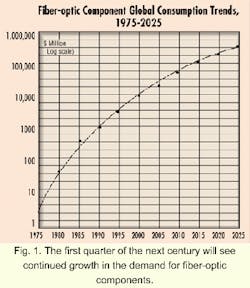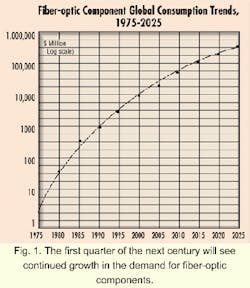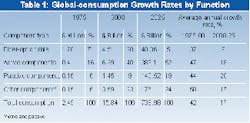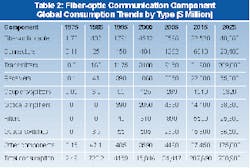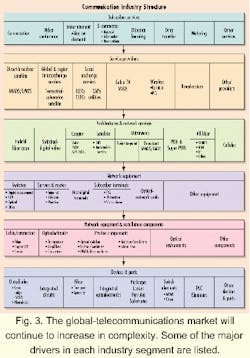Fifty years of fiber optics
The global-consumption value of communication fiber-optic components accelerated from a paltry $2.5 million in 1975 to what will be an amazing $15.8 billion in 2000, in current dollars (see Fig. 1). Very impressive growth will continue, though at a declining rate, to reach $739 billion by 2025. This growth will be matched by comparable growth of fiber-optic communication-related software. Fiber-optic components plus electronic and other components plus software will combine to support global-communication equipment valued at several trillion dollars in 2025. This expansion of communication capabilities will support continued growth in productivity.
Active optoelectronic components contributed 16% to total global fiber-optic component value in 1975, and by 2000 these components will climb to a 40% share of total value ($6.29 billion), as noted in Table 1. This amount includes transmitters, receivers, transceivers, optical amplifiers (fiber and semiconductor), and other active components. Dynamic growth will continue, reaching a 52% share ($383 billion) by 2025. Fiber-optic cable deployment will expand less rapidly, with consumption share dropping to 5%. Components not yet significant in the market, and mostly not yet visible, will hold a 24% share of global consumption by the next quarter centennial.This dramatic expansion of deployed fiber-optic component value underlies the much larger growth of the global broadband-communication network. This network expansion, in turn, has enabled major worldwide increases in transport service revenues, supported by the Internet explosion, massive global-data transfer, and other significant services that were inconceivable in 1975. Without the bandwidth explosion, this massive revenue growth would not have occurred.
The growth of network capacity has been driven by the reasonable expectation of attractive returns on the investment of capital. New technologies (laser diodes, optical-fiber amplifiers, dense wavelength-division multiplexing (DWDM), micro-optoelectromechanical systems, etc.) and government interaction (deregulation and basic R&D support, for example) have been enablers, not drivers. Without expectation of financial, national security (military), or altruistic returns, technologies do not advance beyond demonstration.
It is important to recognize the relatively large impetus for communication bandwidth growth provided by the quest for military superiority. The Internet, for example, originated in, and its development was funded by, national security concerns. Without this need, the Internet would not now exist. Military need is now driving the emergence of tera-FLOP computers in the volume of a small shoebox-a precursor of 2015 commercial desktops, and, incidentally, crammed with very-high-density optical interconnect.
The growth of communication bandwidth over the past quarter-century, and the forecasted growth, mimics the dynamic growth pattern of digital electronic integrated circuits (ICs). In the IC world, we saw very strong continued growth of element quantities, partly offset by falling function prices, supporting strong growth of the markets for end products dependent on ICs and related services. In the digital device realm, the perennial question has been who will need, a decade ahead, such huge quantities of smaller/faster/cheaper computers, copiers, facsimile machines-and the demand has continued. Those who say the recent growth in Internet traffic (and the related expansion of network bandwidth and the supporting equipment) is unprecedented need only to look at the history of the electronic IC and the dynamic growth of equipment and services which the IC made possible.
Similarly, a long lineup of bandwidth-dependent products and services will be spawned and will achieve impressive growth, supported by the rapidly falling cost of transport per gigabit-kilometer. This lineup will include:
- Video entertainment in the form of digital-TV-based, life-size, high-definition, 3D, lifelike color, supported by major advances in program generation, using tens of megabits per receiver
- Videophone, a service that will see large 3D color screens in over 100 million homes worldwide by 2025
- Videoconferencing, one-on-one via the Internet to desktop, laptop, and group-to-group
- Massive, instantaneous, continuous global data transfer among millions of businesses large and small and intraoffice operation of multiple high-end interconnected workstations to form supercomputers
- Data collection from instrumentation for industrial, residential, business, and military applications.
The economics and governmental actions of the world's nations (especially those most advanced) will be come much more interdependent.
Global Networks: A few global subscriber-to-subscriber carriers will dominate global communication. TeleGlobe is a template. AT&T will become a leading global carrier. This globalization will be accomplished through acquisitions, mergers, and partnerships plus new builds and be supported by massive deployment of terrestrial and submarine utility (for lease) fiber cable. Cellular (terrestrial and satellite), satellite long-haul, and cable networks will become integrated into the multipurpose subscriber-to-subscriber networks. Local-exchange carriers will become increasingly irrelevant. Private global optical networks will proliferate. Communication (voice, data, and graphics/ video) to anyone, anywhere, any time, at low cost, will be feasible with a pocket transceiver. Language translation, voice to hard copy, party location/connection, speech recognition, and other expanded services will become common. With continuing merging of networks and expansion of throughput, network interfaces increasingly will accommodate all signal formats on a single channel. Network equipment will become multiprotocol. Equipment vendors correspondingly will merge into larger vendors providing this equipment.
Global Businesses: The merging of common-interest business operations will continue. The dominant communication-dependent businesses will have production, research, management, and customer-interface operations widely dispersed around the globe, supported by high-bandwidth, instantaneous communication. The physical location of knowledge workers will change radically, with major expansion of telecommuting. Small-office/home-office optical-fiber connections will be common, which will support a significant shift in demographics: Hundreds of thousands of workers will relocate to areas of lower cost and/or more pleasant housing. Commuting traffic will be substantially reduced. The upward trend in business travel will level off.
Globalization of government: Developed countries increasingly will coordinate worldwide economic, military, humanitarian, and other activities through global cooperative groups such as the World Trade Organization, International Monetary Fund, North American Free Trade Association, United Nations, military co-ops such as the North Atlantic Treaty Organization, and other linkages.
As we enter the next century, large businesses, plus government and education, dominate fiber-optic communication. Yet over 90% of North American businesses are now small or medium businesses (less than 100 or 100-499 employees, respectively) with only minor fiber connections. Low-cost, ubiquitous broadband communication will support strong growth in the number of small businesses, including home business offices. Telecommute offices will also proliferate. These, plus over 200 million global residential subscribers by 2025, will have fiber connections. Competition will drive business fiber connections to greater reliability through diverse access to buildings (pioneered by Metropolitan Fiber Systems, mesh/ring networks, and optical switches).
Fiber-optic high-bandwidth networks will free communication from transport capacity and cost limits. Digital communication will join digital data processing in a merged stream of strongly expanding market value of products and services.
Over the past decade, major progress in fiber-optic component performance has been achieved. Optical-fiber amplifiers and DWDM systems have evolved into widespread use. Laser-diode modulation rates have multiplied from 622 Mbits/sec to 10 Gbits/sec, with 40 Gbits/sec now in an introductory phase. Fiber performance has improved. These trends will continue, resulting in a total usable singlemode transmission band of over 400 nm that will support over 1000 wavelength channels with modulation rates of 160 Gbits/sec (see Fig. 2).Other advancements include:
The annual growth rate of fiber-optic cable deployment value exceeded 100% per year in the early years of the bandwidth revolution but has been continually shrinking. This trend will continue, reaching near-zero by 2025, and averaging only 9% per year between 2000 and 2025.
Networks will continue to evolve to include global subscriber-to-subscriber networks; consolidation to a few global networks, supported by utility fiber cables; anyone, anywhere, any-time instant instrument-to-instrument voice, video, and data interconnect; and global communication throughput capacity (gigabits x kilometers) expansion by over 10,000 times the year 2000 level. Petabit links will become common.
Just as the growth in bandwidth has mimicked that in ICs, so too have fiber-optic components, to date, remained at the same level of technology and integration as occupied by electronics through the mid-'60s. Electronic circuits consisted of vacuum tubes, discrete resistors/capacitors/inductors, switches, and wire. That all changed with the invention and introduction of the transistor and its next step, the IC, forging a watershed era of electronics. Without solid-state ICs, the current level of electronic equipment technology (and the services this equipment enables) would have been inconceivable.
Although very impressive OEIC results have been demonstrated (especially in the late '80s) by major laboratories worldwide, this technology has yet to reach significant production. Thus, in fiber-optic component use, we are still in the discrete-component, "bolt-together" assembly era. Production quantities and performance limits, however, are now sufficient to encourage phasing into OEIC production. Alcatel, Lucent, Bookham, and others are now moving into volume production of hybrid OEIC transceivers, which will have significant impact on equipment designs in 2000 and the years beyond. By 2025, 2.5-Gbit/sec transceivers will be available at below $10.
Optoelectronic integration will evolve from hybrid to monolithic multichannel units. Sub-nanosecond, highly integrated monolithic optical switches will be available at less than $1 per switch point. High-throughput optical-network switches (ATM, digital crossconnect, and Internet router) will evolve from optical/electronic/optical architecture to transparent optical-channel switches. The rapidly falling per-function cost made feasible by this evolution of fiber-optic component integration will enable dramatic, economically attractive emergence of networks having greatly expanded capacity and capability in applications ranging from micron-level to global reach.
The communication industry in the United States, as it relates to fiber optics, can be roughly explained as consisting of six levels (see Fig. 3). Before MCI pricked the monopoly bubble, the industry was tightly regulated; exhibited modest, steady, easily forecasted growth of services; was performance (versus cost) oriented; featured slowly evolving technology (courtesy of Bell Laboratories); and relied on quasi-proprietary telecommunications equipment. The monopoly grasp gradually weakened over the past quarter-century, resulting in the breakup of the U.S. Bell System and the emergence of cable-TV and cellular-phone service providers, plus local-exchange bypass (competitive access provider) networks, rapid expansion of MCI and Sprint, and other contributions.The communication industry has shifted from turbulent to chaotic over the 1995-2000 span under the impact of the U.S. Telecommunication Deregulation Act (which sparked deregulation and privatization worldwide), plus the explosive emergence of Internet services, service providers, and subscribers. This time period has also seen impressive technology advancement, plus the surge of investment capital into North America as it retreated from Asia and Eastern Europe. We have seen a flood of new company startups, mergers and acquisitions, and restructurings.
Substantial shakedown and shakeout will occur over the next quarter-century, as investment funding returns to a more normal global distribution and as the startups of the '90s phase into head-to-head competition with established vendors. Major corporations that have had little involvement in optical communications to date are now planning aggressive entry.
Traditional local-exchange carriers will wither and/or will be absorbed into global fiber-optic network competitors. Services (voice, video, data, and Internet) and service providers (local-exchange and long-haul telecommunications, cable TV, direct-broadcast satellite, and cellular) will coalesce into a few full-service global networks earning over 80% of communication service revenue.
The past decade has brought a major increase in the transiency of people, especially professionals. This major relocation of professionals between countries, as well as within countries, will expand, which will support the advancement of technology and commerce but have serious social implications relative to individual sense of community.
Jeff Montgomery is chairman of ElectroniCast Corp. (San Mateo, CA).
